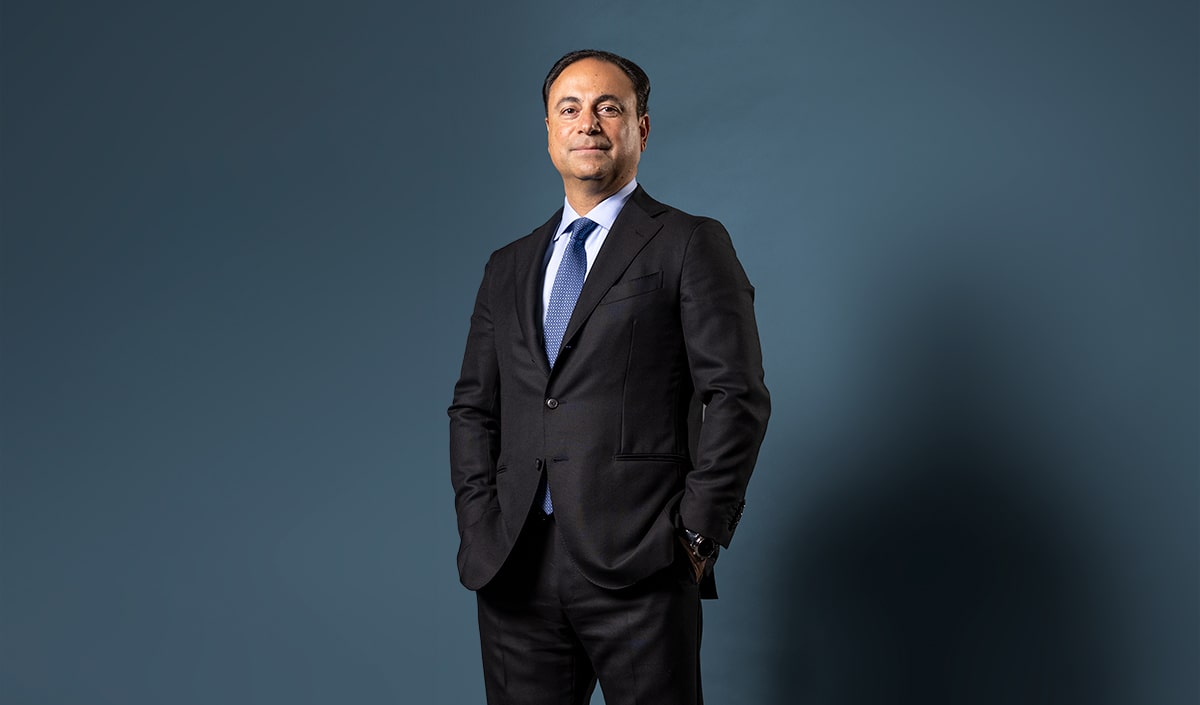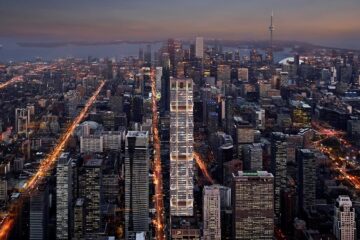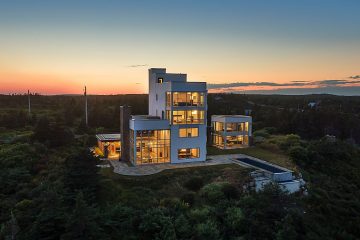Sam Mizrahi: Being The One

Sam Mizrahi is building the tallest building in Canada, an achievement which befits this man of commanding power, vision, determination and drive.
The One Residences at Yonge and Bloor in midtown Toronto is the most documented, complex and notable building to be developed in the city in two generations. It will, at 338 metres (more than 1,000 feet) and 94 storeys high, be the tallest building ever built in Canada and the country’s first “super-tall building.” But, more than that, it will be a symbol of Toronto’s coming of age as a world-class global city, thanks to the vision and determination of Sam Mizrahi, who was born in Tehran, Iran, and moved to Toronto at the age of six with a love of architecture and design.
From humble beginnings in the dry-cleaning business, Mizrahi began building luxury custom homes in Toronto’s tony Forest Hill neighbourhood with his newly founded Mizrahi Developments, graduating to luxury boutique condominium buildings in the exclusive Yorkville area and making a name for his company for it’s innate sense of great locations, high-quality craftsmanship and the style, luxury and design that are reflected in all its developments.
Location, craftsmanship, luxury and design have all come together at The One, designed by London-based architect Foster + Partners, to be not only the tallest building in Canada, but also the best. A mixed-use development anchored by retail, including a five-star hotel and luxury condominiums topped by the most spectacular penthouses in the country, the project is the result of a three-year process in city-building by Mizrahi to receive the proper approvals to build this mega-project.
Construction began in 2017 on what is perhaps Toronto’s most complex development project, now growing rapidly into the skyline. Building something this big and also high on such a tight site at the intersection of Canada’s busiest intersection, and stop two converging subway lines running underneath, takes more than just a little nerve. It has been a synchronistic symphony of logistics and perhaps the best window yet into the vision of Mizrahi — to have the audacity of thinking such a project could be built at this location surrounded by such density.
The result upon completion will be a building of striking design with champagne colour and lighting, which will be a landmark structure in a city already filled with them. It is Mizrahi’s way of giving back to his city, by creating something that will put Canada and Toronto on the map, in terms of international architecture.
Dolce recently sat down with Sam Mizrahi to discuss The One, his business philosophy and what it night be like to stand atop a lofty industry.
Q: Have you always been a visionary?
A: I always looked at the future and looked at how I could step into an industry or a sector that wasn’t being developed or served well and do something different. For me, it was more about: “Can we service a need in a specific area that nobody was servicing?” When we were first doing development, we were doing mid-rise buildings, and most of the smaller custom home builders were not in the mid-rise space, and most of the high-rise builders were not in the mid-rise space, so there was a vacuum that we were filling. We always look at niche markets and where we could come in and do something unique that nobody is doing. In anything we do, that’s what we look at.
Q: Where do you think your business acumen comes from?
A: Definitely my family. A lot of business acumen comes from my father, a lot comes from my mother, but it was a combination of the two of what to do and what not to do, as well as friends and those you associate yourself with as you grow up. A lot of that influence comes from your community and your own personal circles.
Q: Is there an anecdotal story you could share that really taught you a certain lesson that you carry with you today?
A: I would say the most important lesson I learned was, you want everybody who meets you to say they’re better off because they met you and know you. You don’t ever want anybody to meet you and, because they met you, they’re worse off. One of the most important business lessons my father taught me was, make sure everybody who comes into contact with you says that they’re better off knowing you. So, you look at that as your moral compass in life, in business, in family, and you apply that, and I think everything else will go right under those foundations.
Q: You say that every property you purchased for The One was assembled off-market and done through relationship-building. What would you say is your “little black book” for acquiring a property/negotiating?
A: I think the secret to it is knowing the hidden needs of a person. In most of the successful negotiations, it’s not what’s apparent — I would say it’s what’s not apparent. The hidden needs are the key success factor to identify because they’re not identifiable so easily. And once you identify what really the person’s hidden needs are and what problem they are solving for, and you address that, you’re going to gain success in whatever you’re negotiating, because it becomes a win-win.
In most negotiations, when they don’t go well or when they fail, it’s that you haven’t addressed the hidden need. For me, the secret sauce has always been to identify the hidden need in whatever the off-site negotiation is or in whatever I’m doing. If you do that and address that, the rest of it comes together beautifully.
Q: You’ve said before, “It takes more than one person to put a man on the moon.” That being said, can you share all the moving parts of putting your vision together? How do you get people to believe in your vision?
A: I think the way you get people to believe in your vision is to get them to believe you’re going to take them to a better place. The key factor in any leader or any leadership or in anybody who’s going to do anything visionary is: “Are you going to take the people around you and your community and your city and your country to a better place?” It’s a very easy buy-in from everybody around you if you have a road map to do that, and they believe in that. Then, you build a great team and you’re able to do things that most people can’t do or most people thought were impossible to do only because of the fact that they see the vision that you’re actually going to do something that’s going to make life better for them.
Q: What other buildings around the world would you consider to be One Bloor calibre?
A: The Swiss Re building in London, without a question, which Foster + Partners did the architecture for. If you look at buildings in New York, in Manhattan, like 432 Park Avenue, for example, that was just completed a few years ago. I look at which buildings are unique and stand clear of what’s “formula-built,” and those are like The One. The One isn’t formula-built. It’s a very unique, one-of-a-kind building that, for Canada, is something that’s on the same scale as the CN Tower, in terms of putting Canada on the architectural map. We haven’t really done anything to that scale since the CN Tower, since 1977, so I look at that. And I look at buildings around the world and what inspired me on The One was to put Toronto again, architecturally, back — to be in the same realm of other international cities.
Q: Can you speak to some of the challenges you’ve faced?
A: Which ones? There are so many. I mean, every time you do a project to this gravity, there’s going to be challenges. Everything from acquiring the site and actually assembling the site was a challenge because you had over 14 private assemblies to a site that was not for sale, to the zoning, to the approvals, to the financial engineering of a project of this magnitude. The One is approximately now $1.5 billion, and, for a single tower, it’s never been done before in Canada. There were many aspects of it that were incredible challenges, and those incredible challenges are what made it successful. There is no success of magnitude that does not come with extreme challenges. I think if you don’t have challenges, the magnitude of success is equal to those challenges and so, in a way, I’m happy I had the challenges because it allowed the building to be what it is.
Q: Can you speak to the partners that you chose to collaborate with on The One?
A: They were the “Ones” of industry. They are the superstars in each one of their sectors and the scopes of work that we needed. You look at Foster + Partners, out of the U.K., and I would say they’re one of the top architectural firms internationally around the world who were able to envision and be able to put to paper the vision that we had for the city, for The One and for Toronto. They were able to structurally build such a building, with the structural engineers from RJC Engineers, and so forth to do something in this calibre. Again, they were the “Ones” in the industry. Every consulting firm and every partner that we collaborated with were really the superstars in their own industry. I kind of looked at myself like a conductor, where I was bringing in the best percussionist, the best drummers, the best violinists, the best celloists in each area and bringing them together and knowing how to fit them together in concert.
Q: You’ve talked about expressing your art through your developments. Would you consider yourself creative?
A: I look at myself as an entrepreneur, but my canvas for entrepreneurship are my buildings. There are many different canvases for many different artists, but I look at myself as an entrepreneur because that’s my passion, that’s what I love; my DNA is that. I express my entrepreneurship through the developments and through the designs. We’ve done that with every business, whether it was this development or my prior companies; again, that was the canvas that I expressed myself.
Q: What is most important to you when it comes to running and managing your business?
A: Delivering on our promises is the most important thing to me and exceeding expectations.
Q: What would you like the Mizrahi legacy to be?
A: Exceeding expectations and having it seen and known for building buildings that make people’s lives much better, make the city much better and the community much better. And creating an art through those buildings for the country and the city that inspires others to do similar types of developments.
Q: What does your family life look like?
A: It is incredibly busy. Incredibly well-programmed. We live life. Everybody, from my son, my daughter, my wife, myself, individually and united, looks at everyday filling the hours in ways that really make you enjoy and experience life — so it’s very programmed.
Q: Do your children understand the gravitas of what you’re building right now?
A: Yes, because I share it with them all the time when we’re at the dinner table. They hear me in the car on phone calls. They’ve been absorbed in it since they were born. They understand it, maybe better than I do, at times.
Q: Who is your support system?
A: My wife, my best friend.
Q: How do you re-energize?
A: I re-energize with my family by just spending time with them and what I call one-on-one time with either my wife, my son or my daughter, and that re-energizes me. I have a passion for flying, so, for me, every time I fly, it re-energizes and recharges my batteries, and it’s a passion that has worked for me for over 30 years. I’ve been doing it since I was 19.
Q: What types of people are you drawn to? Personality traits, etc.?
A: Self-made, entrepreneurs, people who have overcome great challenges, great struggles. I love all sorts of different people, but the ones who I naturally gravitate toward have defied the odds and had naysayers who said they weren’t going to make it, but they achieved great things [anyway].
Q: Speaking of naysayers, how do you deal with the controversy and pressure of negative press?
A: I don’t listen to it. Anybody who does great things will have negative press. I don’t think you can put yourself into the arena and not expect to have negative press because it’s the blessing and the curse. So, every time you’re going to do something great, there will be a naysayer, and there will be negativity to challenge that and to have it stand up to debate. I think that you need that to be able to have the mirror to see whether you are passionate and you are doing the right thing. I look at the negative press as a reflection of if I’m on the right course, and it gives me determination to punch through a lot of struggles. I don’t look at negative press in a way that it’s a setback; I look at it as a set-up to actually propel you forward in a much more constructive way. It’s hard, obviously, when someone reads that, but it’s a great way to look at what you’re doing and push through. And, without it, I don’t think one can.
Q: What would you like people to know about Sam Mizrahi?
A: I love what I do and I never give up.
Q: Do you work to live or live to work?
A: Both.
Q: What’s your idea of an ideal vacation?
A: Where I’ve done something that gives me joy and I’m experiencing joy, which you can’t experience unless you have others with you. That’s the difference between joy and happiness. Happiness I can do on my own, but joy I can only do with someone else, so a great vacation for me is to experience joy.
Q: How do you take your coffee?
A: I actually don’t drink coffee. I drink a lot of water.
Q: What does la dolce vita mean to you?
A: Making the lives of everybody around you happy and better; by default, if you do that, you’ve got the sweetest life in the world.
www.onebloorwest.com
@mizrahidevelopments
Interview by Estelle Zentil
This interview has been edited for length and clarity.
















































































